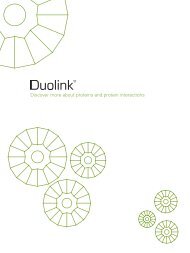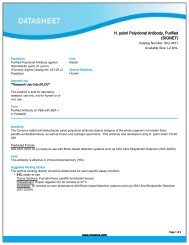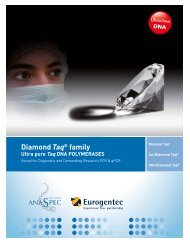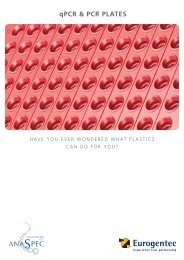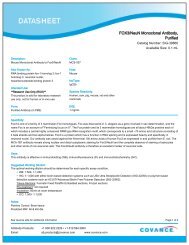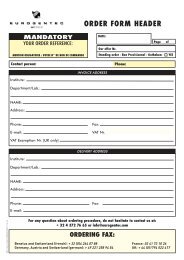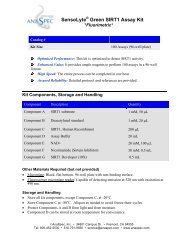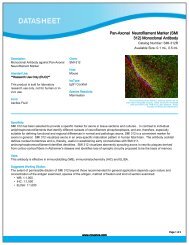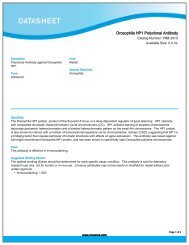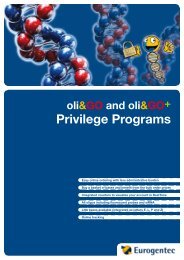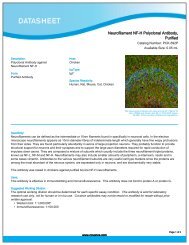HiLyte Fluor - Eurogentec
HiLyte Fluor - Eurogentec
HiLyte Fluor - Eurogentec
You also want an ePaper? Increase the reach of your titles
YUMPU automatically turns print PDFs into web optimized ePapers that Google loves.
AnaSpec, Inc.<br />
2149 O'Toole Ave.<br />
San Jose, CA 95131<br />
USA<br />
Toll-Free: 800-452-5530<br />
Tel: 408-452-5055<br />
Fax: 408-452-5059<br />
E-mail: service@anaspec.com<br />
Internet: www.anaspec.com<br />
Please include the following information to<br />
expedite your order:<br />
Billing and Shipping addresses<br />
� Purchase order number<br />
� Credit card information (for credit card purchase)<br />
� Catalog number and product description<br />
� Unit of measure, size, and quantity<br />
Note: If an order is not taxable, a resale or tax exemption<br />
certificate must be on file.<br />
AnaSpec, Inc.<br />
Integrated Solutions Provider of<br />
• <strong>Fluor</strong>escent dyes<br />
• Assay Kits<br />
• Antibodies<br />
• Peptides<br />
• Combinatorial Chemistry Products<br />
For custom dye syntheses, please contact<br />
service@anaspec.com<br />
ISO 9001:2000<br />
© 2009 AnaSpec, Inc. • 2149 O’Toole Ave. • San Jose, CA 95131 • 800-452-5530 • www.anaspec.com
Table of Contents<br />
<strong>HiLyte</strong> <strong>Fluor</strong> TM Labeling Dyes<br />
Superior <strong>Fluor</strong>escent Labeling Dyes Spanning the Full Visible Spectrum. . . . . . . . . . . . . . . . . . . . . . . . . . . 2<br />
<strong>HiLyte</strong> <strong>Fluor</strong> TM 488 Dye, an Excellent Alternative to FITC . . . . . . . . . . . . . . . . . . . . . . . . . . . . . . . . . . . . . . 3<br />
<strong>HiLyte</strong> <strong>Fluor</strong> TM 555 Dye, an Excellent Alternative to Cy3 TM Dye . . . . . . . . . . . . . . . . . . . . . . . . . . . . . . . . . 4<br />
<strong>HiLyte</strong> <strong>Fluor</strong> TM 594 Dye, an Excellent Alternative to Texas Red®. . . . . . . . . . . . . . . . . . . . . . . . . . . . . . . . . 5<br />
<strong>HiLyte</strong> <strong>Fluor</strong> TM 647 Dye, an Excellent Alternative to Cy5 TM Dye . . . . . . . . . . . . . . . . . . . . . . . . . . . . . . . . . 6<br />
<strong>HiLyte</strong> <strong>Fluor</strong> TM 680 Dye, an Excellent Alternative to Cy5.5 TM Dye . . . . . . . . . . . . . . . . . . . . . . . . . . . . . . . . 7<br />
<strong>HiLyte</strong> <strong>Fluor</strong> TM 750 Dye, an Excellent Alternative to Cy7 TM Dye . . . . . . . . . . . . . . . . . . . . . . . . . . . . . . . . . 8<br />
AnaTag TM <strong>HiLyte</strong> <strong>Fluor</strong> TM Protein Labeling Kits . . . . . . . . . . . . . . . . . . . . . . . . . . . . . . . . . . . . . . . . . . . . . . 9<br />
<strong>HiLyte</strong> <strong>Fluor</strong> TM Labeled Primary and Secondary Antibodies . . . . . . . . . . . . . . . . . . . . . . . . . . . . . Back Cover<br />
<strong>HiLyte</strong> <strong>Fluor</strong> TM Labeled Streptavidins . . . . . . . . . . . . . . . . . . . . . . . . . . . . . . . . . . . . . . . . . . . . . . Back Cover<br />
<strong>HiLyte</strong> <strong>Fluor</strong> is a trademark of AnaSpec, Inc.<br />
Cy3 , Cy5 , Cy5.5 and Cy7 are trademarks of GE Healthcare.<br />
Texas Red® is a trademark of Invitrogen, Inc.<br />
© 2009 AnaSpec, Inc. • 2149 O’Toole Ave. • San Jose, CA 95131 • 800-452-5530 • www.anaspec.com<br />
1
2<br />
Superior <strong>Fluor</strong>escent Labeling Dyes Spanning the Full Visible Spectrum<br />
<strong>HiLyte</strong> <strong>Fluor</strong> dyes, AnaSpec's patented dyes are a series of excellent fluorescent labeling dyes that span the full visible<br />
spectrum. For most of the <strong>HiLyte</strong> <strong>Fluor</strong> dyes, their hydrophilic property makes conjugations to protein easier, minimizing the use of<br />
organic solvents. The resulting conjugates are relatively resistant to precipitation during storage. The <strong>HiLyte</strong> <strong>Fluor</strong> dyes also have<br />
better labeling performance than the classic fluorescent labeling dyes such as FITC and rhodamines. Other features of the <strong>HiLyte</strong><br />
<strong>Fluor</strong> dyes include:<br />
• <strong>HiLyte</strong> <strong>Fluor</strong> dyes are available in a variety of reactive forms.<br />
• <strong>HiLyte</strong> <strong>Fluor</strong> conjugates exhibit more intense fluorescence than other spectrally similar conjugates of classic fluorescent<br />
dyes such as FITC, TAMRA and ROX under similar excitations.<br />
• <strong>HiLyte</strong> <strong>Fluor</strong> dyes are more photostable than the classic fluorescent dyes such as FITC, Cy3 and Cy5.<br />
• <strong>HiLyte</strong> <strong>Fluor</strong> dyes have absorption spectra that match the principal output wavelengths of common excitation sources<br />
such as 488 nm, 555 nm, 633 nm and 647 nm.<br />
• <strong>HiLyte</strong> <strong>Fluor</strong> dyes and their conjugates are available in several distinct fluorescent colors.<br />
• <strong>HiLyte</strong> <strong>Fluor</strong> dyes are highly fluorescent over a broad pH range with little pH sensitivity.<br />
<strong>HiLyte</strong> <strong>Fluor</strong> dyes are the products of our R&D efforts. Additionally, AnaSpec is rapidly expanding our product lines to<br />
meet research needs. We have been developing dyes to solve various limitations with the existing fluorescent labeling reagents while<br />
offering classic fluorescent labeling reagents which have high purity and competitive pricing. We also provide custom synthesis and<br />
contract research services to meet your special needs. Our strong expertise in both the chemistry of fluorescent dyes and peptides<br />
equip us to provide quality services with competitive prices.<br />
1. <strong>HiLyte</strong> <strong>Fluor</strong> 488<br />
2. <strong>HiLyte</strong> <strong>Fluor</strong> 555<br />
3. <strong>HiLyte</strong> <strong>Fluor</strong> 594<br />
4. <strong>HiLyte</strong> <strong>Fluor</strong> 647<br />
5. <strong>HiLyte</strong> <strong>Fluor</strong> 680<br />
6. <strong>HiLyte</strong> <strong>Fluor</strong> 750<br />
1. <strong>HiLyte</strong> <strong>Fluor</strong> 488<br />
2. <strong>HiLyte</strong> <strong>Fluor</strong> 555<br />
3. <strong>HiLyte</strong> <strong>Fluor</strong> 594<br />
4. <strong>HiLyte</strong> <strong>Fluor</strong> 647<br />
5. <strong>HiLyte</strong> <strong>Fluor</strong> 680<br />
6. <strong>HiLyte</strong> <strong>Fluor</strong> 750<br />
Normalized Absorbance<br />
Normalized <strong>Fluor</strong>escence<br />
1.2<br />
1.0<br />
0.8<br />
0.6<br />
0.4<br />
0.2<br />
3 4 5 6<br />
0.0<br />
400 500 600 700 800<br />
Wavelength (nm)<br />
1.2<br />
1.0<br />
0.8<br />
0.6<br />
0.4<br />
0.2<br />
0.0<br />
© 2009 AnaSpec, Inc. • 2149 O’Toole Ave. • San Jose, CA 95131 • 800-452-5530 • www.anaspec.com<br />
1<br />
1<br />
2<br />
2<br />
3 4 5 6<br />
500 600 700 800 900<br />
Wavelength (nm)<br />
Figure 1. Absorption and emission spectra of AnaSpec's patented <strong>HiLyte</strong> <strong>Fluor</strong> dyes.
<strong>HiLyte</strong> <strong>Fluor</strong> 488 Dye, an Excellent Replacement for FITC<br />
Although FITC is still the most popular fluorescent labeling dye for preparing green fluorescent bioconjugates, there are<br />
limitations, such as severe photobleaching for microscope imaging and pH-sensitive fluorescence. Protein conjugates prepared with<br />
<strong>HiLyte</strong> <strong>Fluor</strong> 488 dyes (Ex/Em=497 nm/525 nm) are far superior compared to conjugates of fluorescein derivatives such as FITC<br />
(Figure 2). <strong>HiLyte</strong> <strong>Fluor</strong> 488 conjugates are significantly brighter than fluorescein conjugates and are much more photostable.<br />
Extinction coefficient is 70,000 M -1 cm -1 , with a quantum yield of 0.91. Additionally, the fluorescence of <strong>HiLyte</strong> <strong>Fluor</strong> 488 is not<br />
affected by pH (4-10). This pH insensitivity is a major improvement over fluorescein, which emits its maximum fluorescence only at<br />
pH above 9.<br />
Absorbance<br />
1.2<br />
1.0<br />
0.8<br />
0.6<br />
0.4<br />
Product Size Cat#<br />
<strong>HiLyte</strong> <strong>Fluor</strong> 488 acid 10 mg 81160<br />
<strong>HiLyte</strong> <strong>Fluor</strong> 488 amine, TFA salt 1 mg 81162<br />
<strong>HiLyte</strong> <strong>Fluor</strong> 488 C2 maleimide 1 mg 81164<br />
<strong>HiLyte</strong> <strong>Fluor</strong> 488 hydrazide 1 mg 81163<br />
<strong>HiLyte</strong> <strong>Fluor</strong> 488 succinimidyl ester (SE)<br />
1 mg<br />
5 mg<br />
81161-1<br />
81161<br />
Normalized Absorbance<br />
1.2<br />
1.0<br />
0.8<br />
0.6<br />
0.4<br />
0.2<br />
0.0<br />
<strong>HiLyte</strong> <strong>Fluor</strong> 488<br />
FITC<br />
A<br />
0.0<br />
400 500 600 700<br />
Wavelength (nm)<br />
B C<br />
% Original <strong>Fluor</strong>escence<br />
94<br />
0 20 40 60 80 100 120<br />
0 50 100 150 200<br />
Irradiation Time (min) Time (sec)<br />
Figure 3. Tubulin in human glioblastoma cells was probed with<br />
mouse anti-tubulin, visualized with <strong>HiLyte</strong> <strong>Fluor</strong> 488-conjugated<br />
rabbit anti-mouse IgG (Cat# 28164-H488). Nuclei were stained<br />
with Hoechst 33342 (Cat# 83218).<br />
106<br />
104<br />
102<br />
100<br />
98<br />
96<br />
<strong>HiLyte</strong> <strong>Fluor</strong> 488<br />
Figure 2. Absorption and emission spectra of <strong>HiLyte</strong> <strong>Fluor</strong> 488 (panel A). Panels B and<br />
C show the photostability of <strong>HiLyte</strong> <strong>Fluor</strong> 488 compared to FITC and FAM.<br />
© 2009 AnaSpec, Inc. • 2149 O’Toole Ave. • San Jose, CA 95131 • 800-452-5530 • www.anaspec.com<br />
1.2<br />
1.0<br />
0.8<br />
0.6<br />
0.4<br />
0.2<br />
Normalized <strong>Fluor</strong>escence<br />
5-FAM<br />
FITC<br />
3
4<br />
<strong>HiLyte</strong> <strong>Fluor</strong> 555 Dye, an Excellent Replacement for Cy3 Dye<br />
Although Cy3 is the preferred dye for preparing orange fluorescent bioconjugates, <strong>HiLyte</strong> <strong>Fluor</strong> 555 conjugates are<br />
more photostable and brighter. Compared to the spectra of Cy3 dyes, the spectra of <strong>HiLyte</strong> <strong>Fluor</strong> 555 conjugates are slightly<br />
red-shifted, resulting in an optimal match of filters designed for Cy3 dyes. Extinction coefficient is 150,000 M -1 cm -1 , with a<br />
quantum yield of 0.10. The photostability of <strong>HiLyte</strong> <strong>Fluor</strong> 555 provides researchers with additional time for image capture.<br />
Normalized Absorbance<br />
1.2<br />
1.0<br />
0.8<br />
0.6<br />
0.4<br />
0.2<br />
Product Size Cat#<br />
<strong>HiLyte</strong> <strong>Fluor</strong> 555 acid 5 mg 81250<br />
<strong>HiLyte</strong> <strong>Fluor</strong> 555 amine 1 mg 81252<br />
<strong>HiLyte</strong> <strong>Fluor</strong> 555 C2 maleimide 1 mg 81254<br />
<strong>HiLyte</strong> <strong>Fluor</strong> 555 hydrazide 1 mg 81253<br />
<strong>HiLyte</strong> <strong>Fluor</strong> 555 succinimidyl ester (SE) 1 mg 81251<br />
1.2<br />
A B<br />
1.0<br />
0.8<br />
0.6<br />
0.4<br />
0.2<br />
0.0<br />
400 500 600<br />
0.0<br />
700<br />
Wavelength (nm)<br />
Normalized <strong>Fluor</strong>escence<br />
100<br />
90<br />
80<br />
70<br />
60<br />
50<br />
40<br />
30<br />
<strong>HiLyte</strong> FLuor 555<br />
20<br />
10<br />
0<br />
Cy3<br />
0 2 4 6 8 10 12 14 16<br />
Label Ratio (Dye:Protein)<br />
C D<br />
Figure 4. Absorption and emission spectra of <strong>HiLyte</strong> <strong>Fluor</strong> 555 (panel A). Comparison data<br />
of <strong>HiLyte</strong> <strong>Fluor</strong> 555 and Cy3 emission at different dye to protein ratio (panel B). 3T3<br />
cells incubated with anti-tubulin antibody and goat-anti-rabbit antibodies, labeled either<br />
with <strong>HiLyte</strong> <strong>Fluor</strong> 555 (panel C), or Cy3 (panel D). Nuclei were stained with Hoechst<br />
33342 (Cat# 83218).<br />
Figure 5. Bovine pulmonary artery endothelial cells actins were stained<br />
with biotin-conjugated phalloidin, visualized with <strong>HiLyte</strong> <strong>Fluor</strong> 555<br />
conjugated streptavidin (Cat# 60666). Mitochondria were stained with<br />
mouse anti-Oxphos complex V, visualized with <strong>HiLyte</strong> <strong>Fluor</strong> 488conjugated<br />
goat anti-mouse (Cat# 28175-H488), nuclei labeled with<br />
Hoechst 33342 (Cat# 83218).<br />
© 2009 AnaSpec, Inc. • 2149 O’Toole Ave. • San Jose, CA 95131 • 800-452-5530 • www.anaspec.com<br />
Emission
<strong>HiLyte</strong> <strong>Fluor</strong> 594 Dye, an Excellent Replacement for Texas Red®<br />
<strong>HiLyte</strong> <strong>Fluor</strong> 594 has spectral characteristics similar to those of Texas Red® (Invitrogen), with excitation and emission<br />
wavelength at 593/615 nm in PBS buffer (pH 7.4), and 596/617 nm when conjugated to macromolecules (see spectra below).<br />
The labeling performance and stability properties of <strong>HiLyte</strong> <strong>Fluor</strong> 594 are better than those of Texas Red®. The higher extinction<br />
coefficient (80,000 M -1 cm -1 ) and a lower correction factor (0.17) of <strong>HiLyte</strong> <strong>Fluor</strong> 594 are better than those of Alexa <strong>Fluor</strong> 594<br />
(Invitrogen). The fluorescence quantum yield of <strong>HiLyte</strong> <strong>Fluor</strong> 594 is 0.9 in aqueous solution. <strong>HiLyte</strong> <strong>Fluor</strong> 594 conjugated<br />
streptavidin provides high fluorescence intensity and low background as validated in immunofluorescence staining of mammalian<br />
cells. Biomolecules conjugated to <strong>HiLyte</strong> <strong>Fluor</strong> 594 exhibit little spectral overlap with green-fluorescent conjugates, and can be<br />
efficiently excited by 568 nm line of Ar-Kr laser and by the 594 nm line of orange He-Ne laser.<br />
Product Size Cat#<br />
<strong>HiLyte</strong> <strong>Fluor</strong> 594 acid 10 mg 81271<br />
<strong>HiLyte</strong> <strong>Fluor</strong> 594 amine TFA salt 1 mg 81273<br />
<strong>HiLyte</strong> <strong>Fluor</strong> 594 C2 maleimide 1 mg 81275<br />
<strong>HiLyte</strong> <strong>Fluor</strong> 594 hydrazide 1 mg 81253<br />
<strong>HiLyte</strong> <strong>Fluor</strong> 594 succinimidyl ester (SE)<br />
1 mg<br />
5 mg<br />
81272-1<br />
81272-5<br />
Normalized Absorbance<br />
1.2<br />
1.0<br />
0.8<br />
0.6<br />
0.4<br />
0.2<br />
0.0<br />
0.0<br />
450 500 550 600 650 700 750<br />
Wavelength (nm)<br />
© 2009 AnaSpec, Inc. • 2149 O’Toole Ave. • San Jose, CA 95131 • 800-452-5530 • www.anaspec.com<br />
1.2<br />
1.0<br />
0.8<br />
0.6<br />
0.4<br />
0.2<br />
Normalized <strong>Fluor</strong>escence<br />
Figure 6. Absorption and emission spectra of <strong>HiLyte</strong> <strong>Fluor</strong> 594 (top). Bottom<br />
image shows α-tubulin in 3T3 cells probed with mouse anti-α-tubulin and<br />
visualized with <strong>HiLyte</strong> <strong>Fluor</strong> 594 conjugated goat anti-mouse IgG (Cat#<br />
28175-H594), nuclei were stained with DAPI (Cat# 83210).<br />
5
6<br />
<strong>HiLyte</strong> <strong>Fluor</strong> 647 Dye, an Excellent Replacement for Cy5 Dye<br />
Cy5 is the preferred dye for preparing near-infrared fluorescent bioconjugates. Compared to the spectra of Cy5<br />
dyes, the spectra of <strong>HiLyte</strong> <strong>Fluor</strong> 647 conjugates are only slightly red-shifted. This slight change in absorption spectrum makes<br />
<strong>HiLyte</strong> <strong>Fluor</strong> 647 dyes an optimal match of filters designed for Cy5 dyes. In side-by-side comparison of antibody conjugates of<br />
<strong>HiLyte</strong> <strong>Fluor</strong> 647 dyes and Cy5 conjugates (supplied by other companies), the total fluorescence of <strong>HiLyte</strong> <strong>Fluor</strong> 647 labeled<br />
secondary antibodies is is significantly higher than that of Cy5 conjugates. Extinction coefficient is 250,000 M -1 cm -1 , with a<br />
quantum yield of 0.33. Unlike Cy5 dyes, <strong>HiLyte</strong> <strong>Fluor</strong> 647 dyes have very little change in absorption or fluorescence spectra<br />
when conjugated to most proteins, oligonucleotides and nucleic acids, thus yielding greater total fluorescence at the same degree of<br />
substitution.<br />
Normalized Absorbance<br />
1.2<br />
1.0<br />
0.8<br />
0.6<br />
0.4<br />
0.2<br />
A<br />
0.0<br />
500 600 700<br />
0.0<br />
800<br />
Wavelength (nm)<br />
Product Size Cat#<br />
<strong>HiLyte</strong> <strong>Fluor</strong> 647 acid 5 mg 81255<br />
<strong>HiLyte</strong> <strong>Fluor</strong> 647 amine 1 mg 81257<br />
<strong>HiLyte</strong> <strong>Fluor</strong> 647 C2 maleimide 1 mg 81259<br />
<strong>HiLyte</strong> <strong>Fluor</strong> 647 hydrazide 1 mg 81258<br />
<strong>HiLyte</strong> <strong>Fluor</strong> 647 succinimidyl ester (SE) 1 mg 81256<br />
1.2<br />
1.0<br />
0.8<br />
0.6<br />
0.4<br />
0.2<br />
Normalized <strong>Fluor</strong>escence<br />
RFU<br />
35000<br />
25000<br />
15000<br />
5000<br />
<strong>HiLyte</strong> <strong>Fluor</strong> 647<br />
Alexa <strong>Fluor</strong> 647<br />
DyLight 647<br />
Cy5<br />
0<br />
0 200 400 600<br />
Rabbit IgG (ng/well)<br />
DC DE<br />
Figure 7. Absorption and emission spectra of <strong>HiLyte</strong> <strong>Fluor</strong> 647 (panel A). Performance of<br />
dye-goat anti-rabbit IgG conjugates (panel B). <strong>HiLyte</strong> <strong>Fluor</strong> 647 and Alexa <strong>Fluor</strong> 647<br />
photostability over time (panel C). 3T3 cells incubated with anti-tubulin antibody and goatanti-rabbit<br />
antibodies, labeled either with <strong>HiLyte</strong> <strong>Fluor</strong> 647 (panel D), or Cy5 (panel E),<br />
nuclei were stained with Hoechst 33342 (Cat# 83218).<br />
Figure 8. α-Tubulins of bovine pulmonary artery endothelial cells were probed<br />
with biotin-conjugated mouse anti-α-tubulin, visualized with <strong>HiLyte</strong> <strong>Fluor</strong> 647<br />
conjugated streptavidin (Cat# 60667). Mitochondria were detected with mouse<br />
anti-Oxphos V complex, visualized with <strong>HiLyte</strong> <strong>Fluor</strong> 488-conjugated goat<br />
anti-mouse (Cat# 28175-H488), nuclei stained with DAPI (Cat# 83210).<br />
0.4<br />
0 50 100 150 200 250 300<br />
Irradiation Time (min)<br />
© 2009 AnaSpec, Inc. • 2149 O’Toole Ave. • San Jose, CA 95131 • 800-452-5530 • www.anaspec.com<br />
B<br />
A/A 0<br />
1.2<br />
1.0<br />
0.8<br />
0.6<br />
C<br />
<strong>HiLyte</strong> <strong>Fluor</strong> TM 647<br />
Alexa <strong>Fluor</strong> TM 647
<strong>HiLyte</strong> <strong>Fluor</strong> 680 Dye, an Excellent Replacement for Cy5.5 Dye<br />
With a peak excitation at 678 nm and emission maximum at 699 nm, <strong>HiLyte</strong> <strong>Fluor</strong> 680 dyes are spectrally similar<br />
to Cy5.5 dyes. <strong>Fluor</strong>escence emission of <strong>HiLyte</strong> <strong>Fluor</strong> 680 dyes is well separated from that of other commonly used red<br />
fluorophores, such as TAMRA, R-phycoerythrin and <strong>HiLyte</strong> <strong>Fluor</strong> 647 dyes, making it ideal for three and four-color labeling.<br />
Extinction coefficient is 190,000 M -1 cm -1 , with a quantum yield of 0.36.<br />
Product Size Cat#<br />
<strong>HiLyte</strong> <strong>Fluor</strong> 680 acid 5 mg 81260<br />
<strong>HiLyte</strong> <strong>Fluor</strong> 680 amine 1 mg 81262<br />
<strong>HiLyte</strong> <strong>Fluor</strong> 680 C2 maleimide 1 mg 81264<br />
<strong>HiLyte</strong> <strong>Fluor</strong> 680 hydrazide 1 mg 81263<br />
<strong>HiLyte</strong> <strong>Fluor</strong> 680 succinimidyl ester (SE) 1 mg 81261<br />
Normalized Absorbance<br />
1.2<br />
1.0<br />
0.8<br />
0.6<br />
0.4<br />
0.2<br />
0.0<br />
600 700<br />
Wavelength (nm)<br />
800<br />
© 2009 AnaSpec, Inc. • 2149 O’Toole Ave. • San Jose, CA 95131 • 800-452-5530 • www.anaspec.com<br />
1.2<br />
1.0<br />
0.8<br />
0.6<br />
0.4<br />
0.2<br />
0.0<br />
Normalized Flurescence<br />
Figure 9. Absorption and emission spectra of <strong>HiLyte</strong> <strong>Fluor</strong> 680<br />
<strong>HiLyte</strong> <strong>Fluor</strong> <strong>Fluor</strong> Dyes<br />
Spanning the spectrum<br />
Figure 10. α-Tubulin in 3T3 cells probed with mouse anti-tubulin,<br />
visualized with <strong>HiLyte</strong> <strong>Fluor</strong> 680-conjugated rabbit-anti-mouse<br />
IgG (Cat# 28164-H680), nuclei stained with DAPI (Cat# 83210).<br />
7
8<br />
<strong>HiLyte</strong> <strong>Fluor</strong> 750 Dye, an Excellent Replacement for Cy7 Dye<br />
Spectrally similar to Cy7 dye, <strong>HiLyte</strong> <strong>Fluor</strong> 750 dye is the longest-wavelength <strong>HiLyte</strong> <strong>Fluor</strong> dye currently available.<br />
Its fluorescence emission maximum at 778 nm is well separated from commonly used far-red fluorophores, including <strong>HiLyte</strong> <strong>Fluor</strong><br />
647, <strong>HiLyte</strong> <strong>Fluor</strong> 680 or allophycocyanin (APC), facilitating multicolor analysis. Extinction coefficient is 275,000 M -1 cm -1 , with a<br />
quantum yield of 0.7. With a peak excitation at ~753 nm, conjugates of <strong>HiLyte</strong> <strong>Fluor</strong> 750 dyes can be excited by a xenon-arc lamp<br />
or dye-pumped lasers operating in the 720–750 nm range.<br />
Product Size Cat#<br />
<strong>HiLyte</strong> <strong>Fluor</strong> 750 acid 5 mg 81265<br />
<strong>HiLyte</strong> <strong>Fluor</strong> 750 amine 1 mg 81267<br />
<strong>HiLyte</strong> <strong>Fluor</strong> 750 C2 maleimide 1 mg 81269<br />
<strong>HiLyte</strong> <strong>Fluor</strong> 750 hydrazide 1 mg 81268<br />
<strong>HiLyte</strong> <strong>Fluor</strong> 750 succinimidyl ester 1 mg 81266<br />
Normalized Absorbance<br />
1.2<br />
1.0<br />
0.8<br />
0.6<br />
0.4<br />
0.2<br />
0.0<br />
600 700 800 900<br />
Wavelength (nm)<br />
© 2009 AnaSpec, Inc. • 2149 O’Toole Ave. • San Jose, CA 95131 • 800-452-5530 • www.anaspec.com<br />
1.2<br />
1.0<br />
0.8<br />
0.6<br />
0.4<br />
0.2<br />
0.0<br />
Normalized <strong>Fluor</strong>escence<br />
Figure 11. Absorption and emission spectra of <strong>HiLyte</strong> <strong>Fluor</strong> 750<br />
(top). Bottom image shows an in-vivo image of a rat injected<br />
with 20 nmol of c[RGDyK(<strong>HiLyte</strong> <strong>Fluor</strong> 750)] peptide-dye<br />
conjugate 3h post injection (image courtesy of J. Rey, Univ. of<br />
South Florida).
AnaTag Protein Labeling Kits<br />
The AnaTag <strong>HiLyte</strong> Plus Protein Labeling Kits provide a convenient way to label proteins using the succinimidyl ester<br />
(SE) reactive form of the <strong>HiLyte</strong> Plus dyes. The succinimidyl ester shows good reactivity and selectivity with aliphatic amines of<br />
the protein and forms a carboxamide bond, which is identical to, and is as stable as the natural peptide bond. <strong>HiLyte</strong> Plusprotein<br />
conjugates may be used for immunofluorescent staining, fluorescent in situ hybridization, flow cytometry and other<br />
biological applications. Each kit has all the essential components for performing the conjugation reaction and for purifying the<br />
<strong>HiLyte</strong> Plus-protein conjugates.<br />
Figure 12. The succinimidyl ester (SE) group of the fluorophore reacts with the amino group of<br />
lysines on the protein to form a stable carboxamide bond.<br />
Table 1. AnaTag Protein Labeling kits are available in large scale (3x5 mg) or imicroscale (3x200 ug)<br />
labeling sizes.<br />
Product<br />
Abs / Em<br />
(nm / nm)<br />
3 x 5 mg 3 x 200 ug<br />
AnaTag <strong>HiLyte</strong> <strong>Fluor</strong> 488 Protein Labeling Kit 499 / 523 72047 72048<br />
AnaTag <strong>HiLyte</strong> <strong>Fluor</strong> 555 Protein Labeling Kit 553 / 568 72045 72046<br />
AnaTag <strong>HiLyte</strong> <strong>Fluor</strong> 594 Protein Labeling Kit 596 / 617 72121 72120<br />
AnaTag <strong>HiLyte</strong> <strong>Fluor</strong> TR Protein Labeling Kit 591 / 622<br />
72051<br />
(3x1mg)<br />
72052<br />
AnaTag <strong>HiLyte</strong> <strong>Fluor</strong> 647 Protein Labeling Kit 652 / 669 72049 72050<br />
AnaTag <strong>HiLyte</strong> <strong>Fluor</strong> 680 Protein Labeling Kit 678 / 699 72119 72118<br />
AnaTag <strong>HiLyte</strong> <strong>Fluor</strong> 750 Protein Labeling Kit 754 / 778 72043 72044<br />
Figure 13. Labeling of an amino group (for instance, side chain of lysine) on a biopolymer with a<br />
succinimidyl ester of a dye in 4 easy steps using the AnaTag Protein Labeling Kits.<br />
© 2009 AnaSpec, Inc. • 2149 O’Toole Ave. • San Jose, CA 95131 • 800-452-5530 • www.anaspec.com<br />
9
<strong>HiLyte</strong> <strong>Fluor</strong> Labeled Primary and Secondary Antibodies<br />
AnaSpec's <strong>HiLyte</strong> <strong>Fluor</strong> dye-IgG conjugates are prepared using optimal fluorophore to protein labeling ratio to ensure<br />
high fluorescent signal and uncompromised IgG function. These <strong>HiLyte</strong> <strong>Fluor</strong> labeled primary (Table 2) and secondary<br />
antibodies (Table 3) can be used in applications such as fluorescence microscopy and flow cytometry. AnaSpec also provides<br />
labeling service of our catalog or custom antibodies. Labels include these <strong>HiLyte</strong> <strong>Fluor</strong> dyes or the classic dyes, such as FITC,<br />
TAMRA.<br />
Table 2. Examples of some <strong>HiLyte</strong> <strong>Fluor</strong> labeled primary antibodies.<br />
Product<br />
Table 3. <strong>HiLyte</strong> <strong>Fluor</strong> dyes labeled secondary antibodies.<br />
Product<br />
<strong>HiLyte</strong><br />
<strong>Fluor</strong> 488<br />
<strong>HiLyte</strong><br />
<strong>Fluor</strong> 488<br />
<strong>HiLyte</strong><br />
<strong>Fluor</strong> 555<br />
<strong>HiLyte</strong><br />
<strong>Fluor</strong> 555<br />
<strong>HiLyte</strong><br />
<strong>Fluor</strong> 594<br />
<strong>HiLyte</strong><br />
<strong>Fluor</strong> 647<br />
<strong>HiLyte</strong><br />
<strong>Fluor</strong> 594<br />
<strong>HiLyte</strong><br />
<strong>Fluor</strong> 680<br />
<strong>HiLyte</strong><br />
<strong>Fluor</strong> 647<br />
Anti-α-Actin (smooth muscle), polyclonal 29553-H488 29553-H555 29553-H594 29553-H647<br />
Anti-GST Tag, monoclonal 29531-H488 29531-H555 29531-H594 29531-H647<br />
Anti-His Tag, polyclonal 29673-H488 29673-H555 29673-H594 29673-H647<br />
Anti-His Tag, monoclonal 61250-H488 61250-H555 61250-H594 61250-H647<br />
<strong>HiLyte</strong><br />
<strong>Fluor</strong> 750<br />
Goat anti-mouse IgG (H+L) 28175-H488 28175-H555 28175-H594 28175-H647 28175-H680 28175-H750<br />
Goat anti-mouse IgG (H+L),<br />
highly cross absorbed<br />
61057-H488 61057-H555 61057-H594 61057-H647 61057-H680 61057-H750<br />
Goat anti-rabbit IgG (H+L) 28176-H488 28176-H555 28176-H594 28176-H647 28176-H680 28176-H750<br />
Goat anti-rabbit IgG (H+L),<br />
highly cross-absorbed<br />
61056-H488 61056-H555 61056-H594 61056-H647 61056-H680 61056-H750<br />
Rabbit anti-mouse IgG (H+L) 28164-H488 28164-H555 28164-H594 28164-H647 28164-H680 28164-H750<br />
Rabbit anti-goat IgG (H+L) 28168-H488 28168-H555 28168-H594 28168-H647 28168-H680 28168-H750<br />
Rabbit anti-chicken IgY (H+L) 29709-H488 29709-H555 29709-H594 29709-H647 29709-H680 29709-H750<br />
<strong>HiLyte</strong> <strong>Fluor</strong> Labeled Secondary Antibodies Sampler Kits<br />
Table 4. These sampler kits contain 6 different <strong>HiLyte</strong> <strong>Fluor</strong> labeled secondary antibodies -<br />
<strong>HiLyte</strong> <strong>Fluor</strong> 488, 555, and 647 labeled goat anti-mouse IgGs and goat anti-rabbit IgGs.<br />
Size<br />
Goat anti-mouse IgG<br />
Goat anti-rabbit IgG<br />
Goat anti-mouse IgG<br />
Goat anti-rabbit IgG<br />
(highly cross-adsorbed)<br />
Rabbit anti-mouse IgG<br />
Rabbit anti-goat IgG<br />
6 x 5 ug 72002-5 72001-5 72000-5<br />
6 x 50 ug 72002-50 72001-50 72000-50<br />
<strong>HiLyte</strong> <strong>Fluor</strong> Streptavidin Conjugates<br />
Table 5. A listing of <strong>HiLyte</strong> <strong>Fluor</strong>-streptavidin conjugates.<br />
Product<br />
<strong>HiLyte</strong><br />
<strong>Fluor</strong> 488<br />
<strong>HiLyte</strong><br />
<strong>Fluor</strong> 555<br />
<strong>HiLyte</strong><br />
<strong>Fluor</strong> 594<br />
<strong>HiLyte</strong><br />
<strong>Fluor</strong> TR<br />
<strong>HiLyte</strong><br />
<strong>Fluor</strong> 647<br />
<strong>HiLyte</strong><br />
<strong>Fluor</strong> 680<br />
<strong>HiLyte</strong><br />
<strong>Fluor</strong> 750<br />
Streptavidin 60665 60666 60672-H594 60671 60667 60659-H680 60659-H750<br />
<strong>HiLyte</strong> <strong>Fluor</strong> Labeled Streptavidin Sampler Kits<br />
Table 6. These sampler kits contain streptavidin conjugates of <strong>HiLyte</strong> <strong>Fluor</strong>-488, 555 and 647.<br />
Size <strong>HiLyte</strong> <strong>Fluor</strong> Labeled Streptavidin Sampler Kits<br />
3 x 20 ug 72003-20<br />
3 x 200 ug 72003-200<br />
© 2009 AnaSpec, Inc. • 2149 O’Toole Ave. • San Jose, CA 95131 • 800-452-5530 • www.anaspec.com



